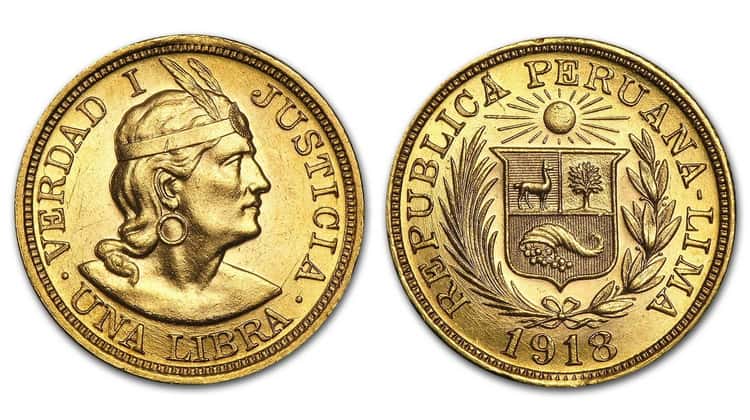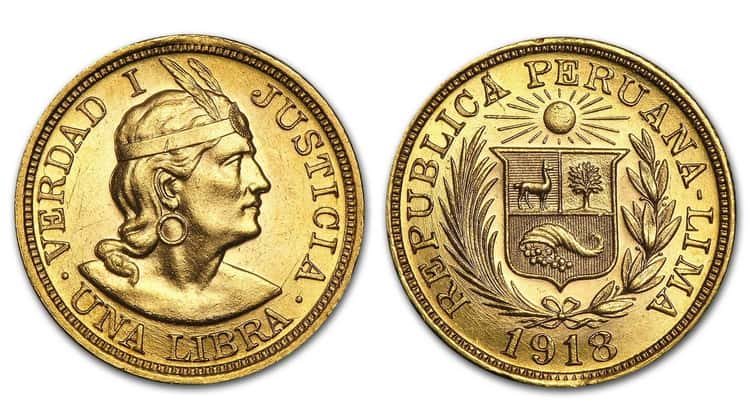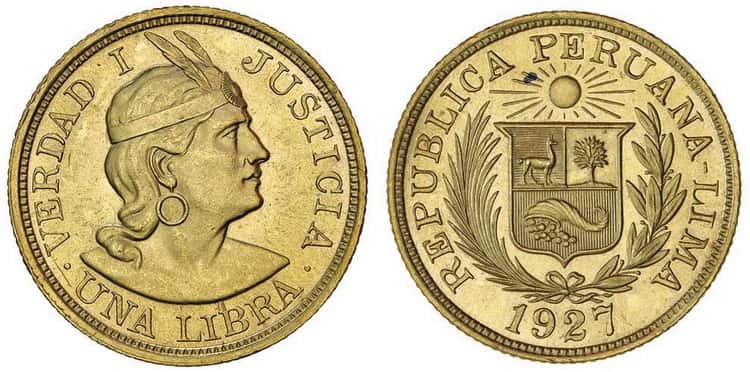

1 Peruvian Libra (1898-1969) is a gold coin with its own interesting history. The emergence of the monetary unit is associated with the long-awaited deliverance from the powerful Spanish government and the establishment of the independence of the state. The new currency was intended for international trade, but its circulation was relatively low, which adds to it even greater collectible value. You can find all 1 Libra Peruvian gold coins in our catalog.
History
For collectors, the words “Peru” and “precious metals” are the inseparable concepts. Since ancient times, gold and silver were mined in large quantities on the territory of this country, then ritual jewelry and various handicrafts of incredible beauty were made. In those days, Peruvian masters, with a rich imagination, created unique pieces. The countless riches of the pre-Columbian epochs are now a part of historical expositions of natural history museums located in the USA (New York), France (Paris) and Great Britain (London).

Peru’s wasteless wealth attracted colonialists from Spain. Pure gold, sometimes not even without need to process from impurities, was mined throughout the territory (for the period from 1503 to 1650, about 181,333 kg of gold and 16,886,815 kg of silver were delivered to Spain). On the conquered lands, the Spaniards introduced new laws and their own monetary system. During the period of colonization, the Peruvian currency was represented in reales, centavos and escudos.
Did you know? Studies show that in Peru, before the arrival of the Spaniards, fine copper axes, shells and coca leaves were used as money. Precious metals and coins made from them were needed for ceremonial rather than economic purposes. The first coins in the modern sense, which circulated around the country, were brought by the Spanish conquerors in 1532. In 1565, 30 years after the foundation of Lima, King Philip II ordered to build the Mint, which began to function only 3 years later.
Gold is one of the main reasons why Spain tried to keep Peru, but after the revolution, which lasted about 100 years, in 1822, the country gained its independence. It took about 20 years for the new government to replace the old currency with its own Peruvian gold and silver coins with the original design − soles and centavos. All Peruvian gold and Silver coins in our catalog. In 1863, the country almost recovered from the crisis, but the First and then the Second War of the Pacific retarded Peru’s money production.
Did you know? In comparison with modern Peruvian currency, colonial coins had a high purchasing power. One real was enough for one person to be fed during the day. Food prices were fairly stable because the precious metal retained its value over time. In 1575, 1 fanega (about 45 kilograms) of corn cost 18 reales, and 1 aroba (about 11 kilograms) of sugar cost 48 reales. In 1600, a young male slave could be bought for 480 pesos, and a woman for 560 pesos. Almost 100 years later, 1 corn fanega cost 26 reales, and fanega sugar 30 reales.
Only by 1897, the Peru Mint regained its role to issue national currency. By the end of the 19th century, renewed equipment was brought from England and the production of gold coins was established for the development of the national economy. As the main monetary unit 1 gold libra was chosen. The government adopted the gold standard of Great Britain, the British sovereign was taken as a basis. In the same year, a ban was imposed on coinage of money ordered by private companies. The Peruvian Mint was completely transferred to state administration.

The first series of 1 libra was published in 1898. During the entire period of minting the circulation was small (except for 1917). These coins were needed by the government for transactions with other countries, since many large states refused to accept Peru’s paper currency. New samples were highly appreciated in other countries, therefore they were used in international trade relations. Products differed with the impeccable quality of coinage and purity of the precious metal. A high quality equipment from the UK and advanced technology were used for the production.
In total there were three denominations of libra:
- 1 Peruvian libra 1989-1969
- 1/2 of the Peruvian libra of 1902-1913
- 1/5 of the Peruvian libra of 1905-1939.
In 1901, the monetary system was updated in Peru, bringing it in line with the gold standard. 1 libra began to be equal 10 silver soles. This system was used until 1932. From 1930 to 1969 coins of this value were already minted in bronze. You can find all 1/2 Libra and 1/5 Libra Peruvian gold coins in our catalog.
Did you know? The world crisis of 1929 caused a sharp rise in the gold price, which is internationally considered the best investment of money. This tragedy violated the monetary order and led to a massive abandonment of the gold standard. For this reason, the last issue of the Peruvian 1 libra from the precious metal was held in 1930.
Design
Despite the fact that the first investment coins appeared only in 1967 (Krugerrand, South Africa), experts say that in terms of composition and quality, the first could be 1 Peruvian libra. It was based on the same imperial British standard, which was used for modern investment designs, including the Krugerrands. This coin had a gold content like sovereign, and its weight was 113 facets (about 7.9881 grams). The same standard was used in India and Australia.
Characteristics of 1 Peruvian Libra (1898-1969)

Material: gold.
Ingredients: 917/1000.
Weight: 7.9881 grams.
Net Weight: 7.3300.
Diameter: 2 mm.
Thickness: 1.50 mm.
Obverse: On the obverse in the center there is the national emblem of Peru, supported on each side by two different branches: palm and laurel. The sun shines over the heraldic shield. The inscription “REPUBLICA PERUANA-LIMA” extends almost along the entire length of the rim, leaving room for the year of issue (the date is indicated along the lowest rim).
Did you know? On the obverse side of the 1 libra coin there is the first Inca Peru − Manco Capac, the founder of the Tawantinsuyu state with the center in Cuzco.
Reverse: The reverse side of 1 libra is decorated with a bust of an Indian (Inca warrior − the indigenous people of Peru), turned to the right. On the head there is a bandage, and in the ear there is an earring in the form of a hoop. The reverse inscription is “VERDAD I-JUSTICIA”. The letters are bent around the top half of the rim. At the bottom edge under the image there is the denomination of the coin “UNA LIBRA”.
Circulation
1 Peruvian libra of 1898-1969 was published in small editions. This is due to the fact that the main trade was conducted with the UK, for this there was enough annual release in the amount of 60,000 to 100,000 coins.
1 Peruvian libra was minted every year:
- 1900 − 64,000 pcs.
- 1901 − 81,000 pcs.
- 1902 − 89,000 pcs .
- 1903 − 100,000 pcs .
- 1904 − 33,000 pcs.
- 1905 − 141,000 pcs .
- 1906 − 201,000 pcs.
The largest batch of coins was minted in 1917. Circulation reached a record number for Peru − 1 928 000 samples. In subsequent years, the number of minted Peruvian libra decreased. If in 1918 the Mint produced 600,000 coins, in 1922 it produced 13,000, and in 1930 − 1,050 samples.
Cost of coins:
The price of 1 Peruvian libra is noticeably higher than the denomination of the precious metal spent on stamping. Immaculately preserved samples at auctions sell for $ 540, and coins with lower quality for $ 284.
Comments
No commens yet.